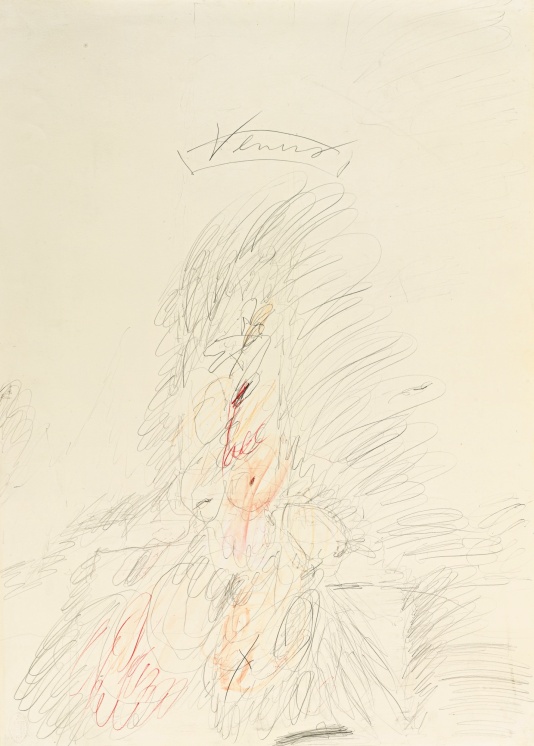
I don’t think I’ve ever seen a more straightforwardly figurative Cy Twombly drawing than Venus, 1962, pencil, coloured pencil, and watercolour on paper: 70 x 50 cm. It looks distinctly like a figure, or two very different figures in fact. The first is a head and shoulders, there is pink where a face might be, with curled hair around it, there are what look like the suggestions of clothes over shoulders in the pencil grey around the pink, there might even be a tie. Then, within this outer figure there is what looks like a more whole female naked figure, the venus of the title, there are breasts with nipples, there are thighs and a scribbled pubic area. This figure is obviously more likely, the word ‘Venus’ is written in an arc in the upper part of the image above what would be the head, but neither is clear or certain. Some violently used red line right in the centre of the drawing could be another word, ‘face’ or ‘lace’. All of the marks are augmented in a way that makes for a convincingly human like form with a shadow cast behind it. There is often an all over quality to Twombly drawings and paintings where areas of concentrated intensive mark making are spread across the whole rectangular surface, however the marks here are organised differently, the upper part of the paper left deliberately empty, acting as a background/backdrop. I like the way Twombly mixed his drawing media like a child; pencil scratched into wax or oil crayon, or scratched into wet domestic paint, he was clearly unconcerned about its longevity. I also like the way that in this drawing he uses a word as a way of making us interpret through a layer of meaning, in this case the Roman mythology which became a vale through which his work was seen after his move to Rome where he apparently lived near the Colosseum and the Forum, among the ruins. I can think of many reasons to move to Rome, one being to be among its great layers of ancient history and I imagine the everyday experience of ancientness might have fed into Twombly’s work in a way that made him refer to mythology, architecture and statuary almost unconsciously.